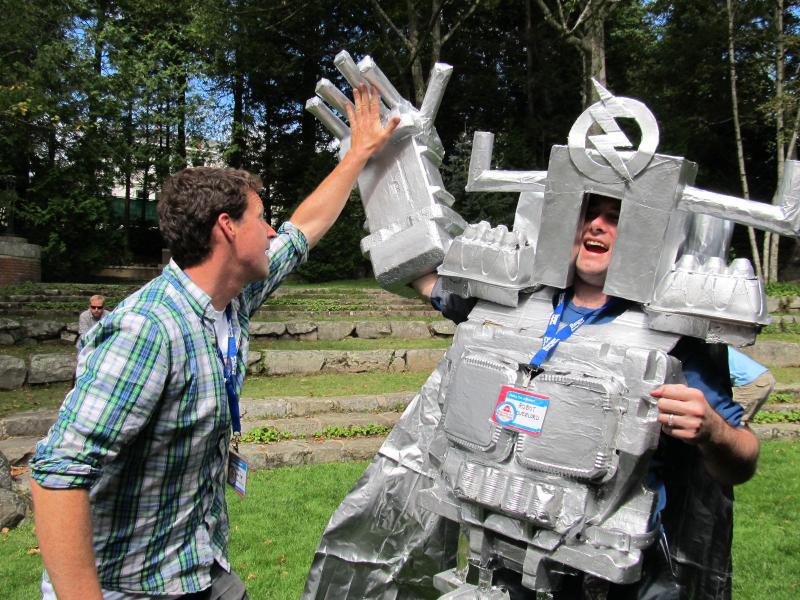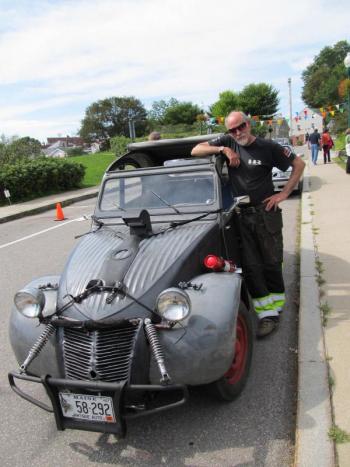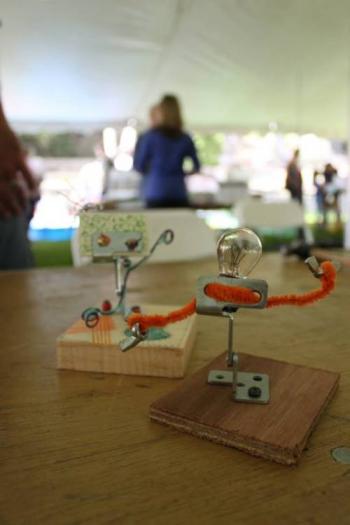More than 900 turn out to the first Midcoast Mini Maker Faire
CAMDEN — Camden’s “greatest show and tell” event drew more than 900 people Saturday, making the first ever Midcoast Mini Maker Faire a smashing success.
The town closed off Atlantic Avenue so that more than 20 exhibitors could display their unusual hands-on inventions in the Camden Amphitheatre.
It’s a rare event that can fascinate both kids and adults and with its resourceful do-it-yourself science and technology, robots, crafts and art, this one appealed to everyone — from science geeks to art enthusiasts. Maggi Blue, one of the organizers, said, “How do I personally know it was a success? My almost 7-year-old boy was entertained for two solid hours, didn't want to leave and was dragging me around the booths for a change. That is a testament to the power of our first Maker Faire. He's one picky kid. As a parent, I'm quite smitten and will be waiting in anticipation for next year's Faire.”
The show seemed to be equally split between unusual and interesting modes of transport, robots in their various incarnations and crazy-weird art installations.
Artist-mechanic Jack Churchill unveiled his latest invention, a steampunk 1956 deux cheveux (French for two-horsepower) made by the company Citroen, a cheap, lightweight vehicle made after the war that French peasants could drive. It was designed to carry four people weighing 100 kilos each, 100 pounds of potatoes and can go 38 mph across a newly plowed field.
“If the world ended and you had to build a car, and build it with stuff you found, that’s where my artistic—if you can call it—direction goes,” said Churchill. Churchill’s vehicle stayed true to the original design with wheels that only have three lug nuts, one of which he’d lost driving around town the day before. “The wheel almost came off,” he said. “Luckily, I found someone with a lug wrench.”
Other DIY vehicles included Jory Squibb’s Sunbeam car, a pedal and electric assist quadricycle. He demonstrated its two-sources of power, a 3/4 horsepower motor and the pedal system.
“They work together to go about 25 miles per hour, 80 miles on a charge,” he said.
David Talley displayed the Elf car, made by the North Carolina company Organic Transit. “There are four of these in Maine. Less than 100 have been made. It’s an emission-free sustainable form of transportation,” he said of the orange, 150-pound stripped-down electric pedal car. “You can commute with it and deal with any kind of weather.”
Bill Buccholz’s micro car Dirigo was built from scratch, originally conceived as an entry for the Automotive X Prize, a competition for a 100 mpg practical and manufacturable car.
“We thought we could do that—how hard was that?” he said of his design committee. “We evolved this three-wheeled rear engine front-wheel drive, deisel-powered, side-by-side seating with storage in the back.” It is made with western red cedar and weighs 130 pounds.
“We didn’t want it to be boxy. We wanted some sexy curves,” he said. The car, which goes 75 mph, has been to Boston dozens of times and even to California.
Other people on the move included the Camden-Rockport Middle School Tech Club’s giant moving horse, Thunderbolt, propelled by two high school students. The “clop clop” sound of the horse’s shoes actually come from the banging of hollow coconut shells. Meanwhile, Paul Cartwright was busy demonstrating how his modified unicycles worked.
Next up dominating the Faire were the robots. Many people tend to think “Eh, isn’t that some kind of science fair kid thing?” However, the Faire changed a lot of perceptions, making robots that much more acccessible to the public. Jared Paradee (aka Robot Overlord) held a cardboard robot-making clinic, while CMCA ArtLab provided brown paper “mystery bags” filled with all kinds of bits and pieces like lug nuts and pipe cleaners. Their table was swamped with kids making individual robots. Edward Seidel brought out the baby pool and showed people how to make a $60 underwater robot (ROV—the same mechanical structure that discovered the Titanic.) With the addition of a video camera and other components, this was a fascinating DIY tool to discover the aquatic world without getting wet.
Technology also played a major part, with the Camden Middle School providing a MindLabs robot demonstation, in which they were all programmed to dance to Michael Jackson’s “Thriller.” Nathan Davis mesmerized the crowd with his computer and iPhone-powered interactive art installation (think: the opening sequence of “Doctor Who” and you get the idea). Meanwhile, Watershed School students demonstrated their FabLab: 3-D printing, laminating and constructing of longboard skateboards. See how that turned out here.
The artists at Mini Maker included Shelby Cote, a fanciful hat designer who was wearing a design of her own making, which was a fascinator (a decorative hat) made with the innards of a music box. The Midcoast Yarn Ninjas were busy knitting up some visual graffiti and Susan Cartwright displayed her hand-operated moving sculptures for the inner-kid in everyone. Pilar Nadal of Tired Press demonstrated how her bicycle-powered printing press could make a unique post card, while next to her, Ella Simon also pedaled away on her own invention, the Icycle Bicycle, a pedal-powered ice cream maker.
Lordy, Lord. There were more exhibitors than we could even cover, and the whole thing was a feast for the senses. We too can’t wait for next year’s event. To find out more about the participants and find more photos from the event, visit midcoastmakerfaire.com.
Kay Stephens can be reached at news@penbaypilot.com.





























